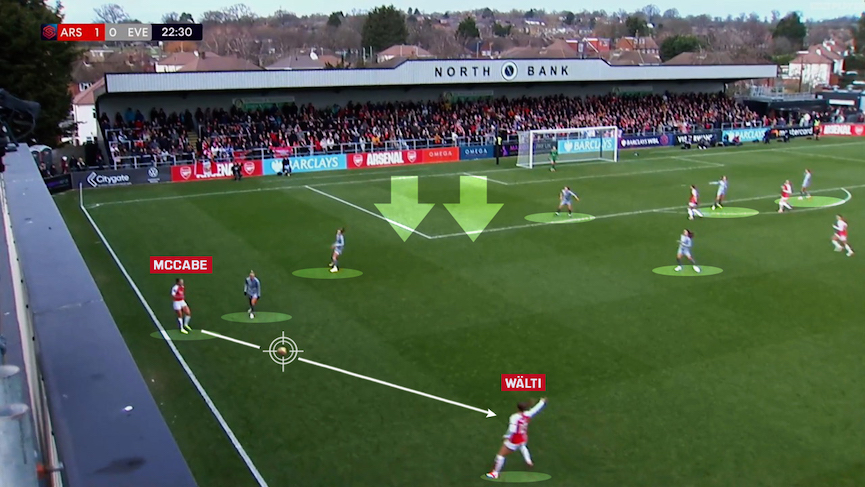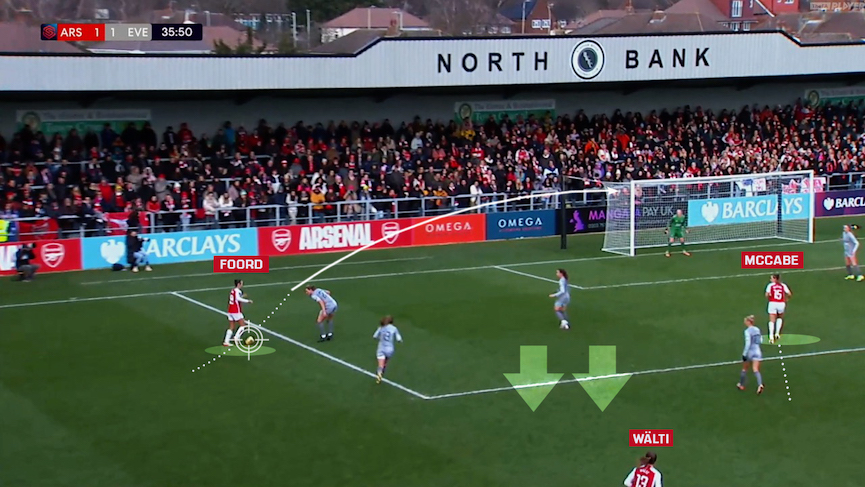Clearly, a big point of analysis for Jonas Eidevall and the players during the winter break has been increasing the amount of fluidity in Arsenal’s attack. Struggling with deep block defences was an unwelcome theme of the first half of the season and one the team and staff are trying to fix.
They have introduced some new partnerships and rotations, with Emily Fox coming into the team. Fox is comfortable inside the pitch and on the touchline to introduce some variety. Vivianne Miedema and Alessia Russo have played together for the last two games. But Arsenal are also slightly tweaking their sixes- Lia Walti and Victoria Pelova- as well.
Both players have been moving into slightly wider spaces in the first two games of 2024 and combining with the winger and full-back on their specific side (Walti on the left and Pelova on the right). I asked Jonas Eidevall about Walti’s assist for Beth Mead’s winning goal from the left half space and whether it was a worked move.
‘We are coming inside in what we call the assist zone more often. Sometimes when teams close that zone behind, when you play the ball back that half space opens up. That is the difference between that goal and a cross, for me that is a pass from Lia Walti.’
Normally deep block defences double up out wide and pack the penalty area. That means that ‘assist zone’ as Eidevall referenced, can sometimes be free and Pelova and Walti have been moving into those areas because you don’t really need two midfielders in the centre circle against a deep block, that is not the space those teams are trying to take away from you. Let’s look at some examples.

As Caitlin Foord plays a ball to Alessia Russo on the left, look at how Walti adjusts her run from the centre of the pitch and curves over towards the left side.

Russo finds Miedema, who doesn’t have a good option inside so she uses Walti, who has pulled into space wide of the Everton defensive block.

On this occasion, she pops the ball back to Russo whose cross is claimed by Courtney Brosnan. Miedema’s positioning makes space for Russo here too, pulling defenders away from Russo with her positioning.

Something similar happens on the right in the next attack. Miedema works the ball to Mead on the right and Pelova immediately snakes her run over to that side to help her out.

Pelova points for the ball on the overlap to Mead but it’s just a bit crowded for the ball to reach Pelova there, but it’s another good example of the 6s pulling out into the half spaces and both Arsenal’s goals emanate from this. Pelova, Mead and Fox are creating a triangle on the right and Walti, Foord and McCabe are doing likewise on the left. This also grants Miedema greater freedom to drift where she likes or to hold her space centrally.

Here’s an example of Miedema floating over to create a wide triangle with Foord and McCabe.

It’s clever positioning from Miedema and a good pass from McCabe and now Miedema is in space. Arsenal tried to use this space often during the game and from this situation, Miedema cuts the ball back to Mead who hits the bar.

For Arsenal’s opening goal, this time Miedema drifts to the right and it’s Pelova again busting a gut to provide the overlap.

Pelova is able to pick the ball up in the half space again and she pulls the ball back for Foord to score. Arsenal’s right six setting up Arsenal’s left winger for a goal. It’s not an accident.

We see that wide support again here, Walti wriggles out of tight space and sets McCabe away on the left and immediately makes a support run over to the left side. Look at how she scans the centre of the pitch as she runs, she can see the centre is well covered and that she is needed in a slightly wider area.

McCabe checks back and uses Walti who is in space. Ideally the team wanted to find Walti and Pelova in these spaces but a little higher. If you look at Everton’s setup here, you can see they have two defenders out wide and plenty in the box, but that little area on the corner of the area is free. It’s an area Walti exploits later on.


McCabe finds Walti here, who nudges the ball wide to Foord and, with McCabe behind her, Walti is encouraged to continue her run and provide the overlap. Regardless of who was where, Arsenal always tried to keep wide triangles.

McCabe is now inverting into midfield where Walti might be, while Wally overlaps Foord as Arsenal aim to retain their shape in that area.

We see a nice wide triangle as Miedema whips a pass to Mead. We can see Fox is inside and so is Pelova, creating that triangle shape again.

Mead goes back To Walti, who finds Pelova. Again, Mead is on the extremity of the pitch with Fox tucked in. Pelova is at the tip of the triangle and plays a nice, angled pass to Mead on the overlap. From here, Mead gets to the byline but her cross is cleared.

Here we see that left triangle maintained again with Walti and McCabe swapped this time. As Foord collects the ball, McCabe makes a run inside where you might expect your central midfielder to be, while Walti drops back more towards left-back but Walti is also eyeing up that space on the corner of the penalty area again. Foord doesn’t use that option this time but Arsenal are trying to make sure it’s available.

As McCabe switches the ball to Fox on the right, it’s Pelova that drifts wide to support her.

Fox finds Pelova and she puts a dangerous ball into the area. It’s another example of one of Arsenal’s central midfielders pulling into wide areas to find the space and create combinations in the half spaces.

As Foord runs into a dead end here, Walti has again pulled wide to support her. Look at McCabe who is pushed in field as Walti and McCabe swap positions again.

Walti tries to find McCabe with an angled pass here, it is half intercepted but finds Miedema in a better position in the half space anyway. Miedema goes through on goal but Brosnan saves.

After a lot of working that space on the left, Arsenal finally make it count. As the free-kick is taken here, look at Walti trotting over to the left side.

McCabe, standing where you would expect the central midfielder to stand, steers the ball out to Walti, where you would expect your left-back to be.

Arsenal fans will be well familiar with how Walti is able to curve those passes with her left foot and she delivers a beautiful flighted ball to the back post for Mead to head home.
A silky Walti cross and a fine header from @bmeado9! 🤌#BarclaysWSL @ArsenalWFC pic.twitter.com/xfGZRIanlv
— Barclays Women’s Super League (@BarclaysWSL) January 20, 2024
Curiously, I found very few examples of Arsenal producing these patterns in the second half. Whether Everton made a tweak, Arsenal backed off or whether Pelova and Walti were asked to be a little more circumspect with the Gunners in the lead I am not sure. But in the first half, it was a very notable facet of their attacking play.





COYGG
Thanks for analysis. It seems like with tactics striker is left not for attack
Thanks, Tim. I’m starting to see the patterns in real time on the pitch, so thanks, Sensei Stillman! 😉 The good thing about this, apart from the effectiveness in creating chances, is that it creates problems for the opposition. If they stay in a low block, we break the lock using the space they have left undefended, if they don’t, we get in anyway. We were continually creating situations they haven’t prepared for. Once again, we use their weapon against them. It must be such fun playing football at this level – a physical challenge, a challenge of your resolve… Read more »